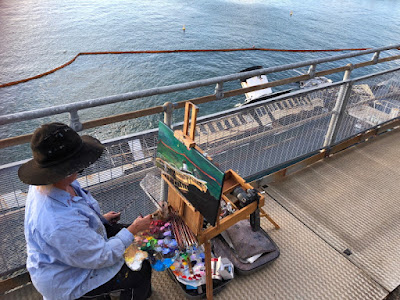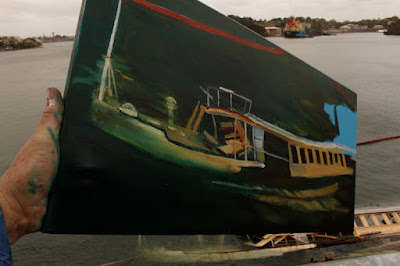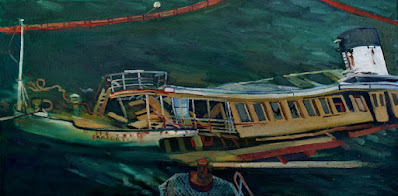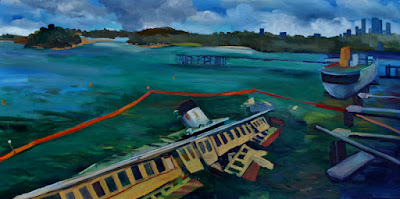“How did you go bankrupt?” Bill asked.
“Two ways,” Mike said. “Gradually and then suddenly.”
From the 1926 novel “The Sun Also Rises” by Ernest Hemingway
Another version of "Hemingway's Law of Motion " is by the economist Rudiger
Dornbusch:
"The crisis takes a much longer time coming than you think, and then it happens much faster than you would have thought."
It's a common human failing that we rarely act until a crisis happens.
The initial effects happen gradually.
Drip by drip.
It's not a problem...
Until it is.
One day 'Gradually' will always become 'suddenly'.
This is the tipping point.
I will leave it to others to recount the long, troubled history of the MV Baragoola.
The best account I've found is in an article in the Manly Daily.
 |
| Half finished panorama of Sydney Harbour from the Baragoola 20th February 2016 oil on canvas 31 x 153cm Against the staircase of MV Baragoola |
 |
| Half finished panorama of Sydney Harbour from the Baragoola 20th February 2016 oil on canvas 31 x 153cm |
This is the last painting I started on board the Baragoola, before her change of ownership.
 |
| The artist painting a half finished panorama of Sydney Harbour from the Baragoola 20th February 2016 oil on canvas 31 x 153cm |
A couple of years later I finally returned after dealing with a serious illness in the family, to find a change of regime. Instead of the previous volunteers there was someone described variously as either the new "shipkeeper" or "owner".
The ship was in a far more dilapidated condition and the gangplank was frankly dangerous with loose and missing railings.
I was welcomed at first, then gradually the behaviour of those on board became strange and then alarming. I desperately wanted to remove my paintings and easel, but I would have needed help across the ricketty gangplank- and I knew I wouldn't get any.
The terrible condition of the vessel and gangplank as well as my reservations about the attitude and behaviour of the recent occupants made it
impossible for me to ever return to the vessel to retrieve my belongings. I wondered at first if I was over-reacting- until I asked several people if they could escort me back on the vessel, and they all refused, saying they wouldn't be game to set foot on board.
I kept hoping that people with expertise and unlimited funding would one day take control, but knew that this wasn't going to happen.
The half-finished canvas above, as well as my easels, paint and many other canvases went down with the ship.
The
mooring lines still hold parts of it in place, while the weight
of water, tide and debris pulls the rest away.
As I paint the wreck from the Coal Loader and the Cape Don, I watch my old canvases lap against the boom with the other flotsam.
"So we beat on, boats against the current, borne back ceaselessly into the past."The last line from the 1925 novel "The Great Gatsby" F. Scott Fitzgerald











